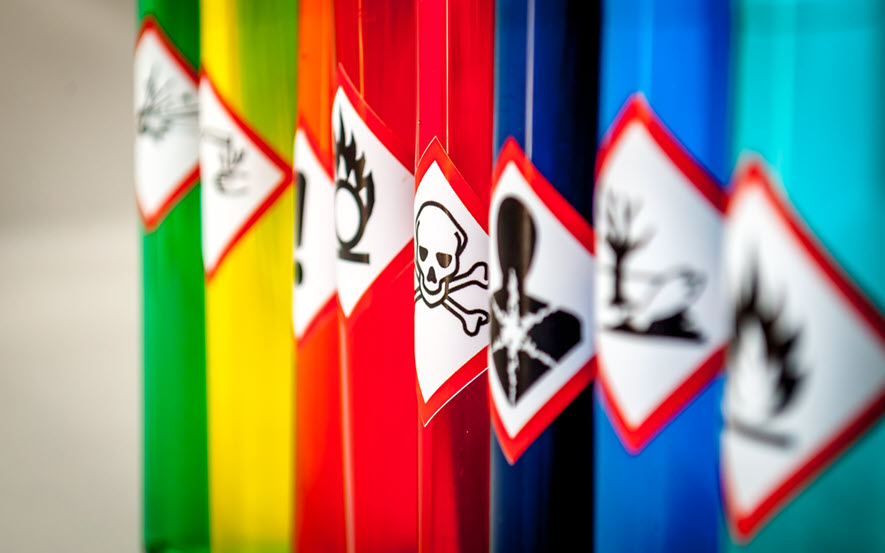
Chemical Label Literacy: What Your Team Needs to Know About Hazardous Materials in the Workplace

On April 16th, 1866, a boat pulled into a San Francisco harbor. It was a shipment of unmarked crates that had come from New York by way of the Panama Canal. When the boat arrived, a dock worker noticed that one of the crates was leaking something oily. The dock workers brought the box to their superiors because they wanted to see what it was and determine who could be billed for the mess. The substance in the box was nitroglycerin.
One swing of a hammer to loosen the lid of the box created an explosion that killed fifteen people and sent debris for blocks. This event is commonly referred to as “The San Francisco Incident” by those who discuss workplace safety because it was a tipping point that led to the development of the first chemical and hazardous material labels legislation.
While your workplace may not be dealing with leaky crates of nitroglycerin, it probably has plenty of hazardous chemicals and materials around. So how do you keep your employees safe? Today’s chemicals have some pretty tight restrictions on their labeling thanks to the Globally Harmonized System of Classification and Labeling (GHS). By understanding these labels, your team will have the knowledge to use, store, and clean up these products safely.
The key is making sure that any and all employees who may come in contact with these materials have the proper chemical label literacy.
Common Workplace Hazardous Materials
You may think that it’s only industrial companies and manufacturing that are likely to have dangerous materials around, and they do account for the bulk of chemical-related accidents, but nearly every business has some form of hazmat on site. Some common hazardous materials found in workplaces include:
- Chlorine – Used in many industries such as paper, leather, and lumber production as well as the making of printing chemicals. Even the local swimming pool keeps it around.
- Hydrochloric Acid – It may be clear and odorless, but this substance can do serious damage to the eyes, organs, and skin. It’s used in some strong cleaning agents and found in batteries.
- Sulfuric Acid – Also clear and odorless, sulfuric acid can cause chemical burns and blindness. You can find it in dyes, detergents, and fertilizers.
- Ammonia – Frequently used for cleaning, ammonia gas is very dangerous and all too common.
- Carbon Monoxide – It’s not just something that comes out of your car’s tailpipe. Carbon monoxide can build up where any fuel-burning engine is running and there is poor ventilation.
These are just a few of the most common culprits when it comes to workplace hazmat issues, but there are many more out there.
GHS Chemical Hazard Labels
In 1992, at the United Nations Earth Summit, the GHS was born. It’s a standardized system for chemical information that can be recognized and understood across the globe. Prior to its development, every country had its own methods for chemical and hazardous material labels, which created confusion and even danger as chemicals were bought, sold and shipped internationally. GHS compliance is now required worldwide.
To meet GHS requirements, every label for hazardous chemicals must have:
- Name, Address and Telephone Number
- Product Identifier
- Signal Word
- Hazard Statement(s)
- Precautionary Statement(s)
- Pictogram(s)
The pictograms are small pictures on the label that can help identify hazard types without the use of words, eliminating language barriers. Nine GHS pictograms exist, each representing a hazard classification, but only 8 are considered mandatory by OSHA. At this point in time, the environmental pictogram is optional.
Another major part of GHS labeling is the requirement for each product to have a Safety Data Sheet (SDS) included in its packaging. These sheets provide crucial information such as proper use and storage, first-aid and fire-fighting measures, suggested or required personal protection measures, and proper disposal and much more.
The GHS pictograms provide essential information at a glance, regardless of language, while the SDS sheets provide the complete playbook for each chemical.
GHS Literacy is Your Responsibility
As an employer, the safety of your workforce is your responsibility. What’s more, workplace hazardous material safety training is an OSHA requirement. According to OSHA, “All employers with hazardous chemicals in their workplaces must have labels and safety data sheets for their exposed workers, and train them to handle the chemicals appropriately.” That means if you do not have your chemicals labeled properly or your staff is not trained to read those labels, your business could be subject to significant fines.
To make things easier on employers, OSHA has a number of hazard communication and GHS resources available.
Chemical and hazardous material incidents can happen in a heart beat and they can be deadly. A flammable chemical is left too close to a flame or sparks. An heater is running but there is no ventilation. A worker uses the wrong product to clean up a spill. When these items aren’t treated with extreme care, lives are in danger.
Help your workforce stay safe by helping them understand the chemical and hazardous material labels and safety data sheets. By understanding the materials they work with, they can protect themselves and their coworkers from harm. The San Francisco Incident was tragic, but it was a catalyst that has lead to thousands, if not millions, of safer workplaces.

